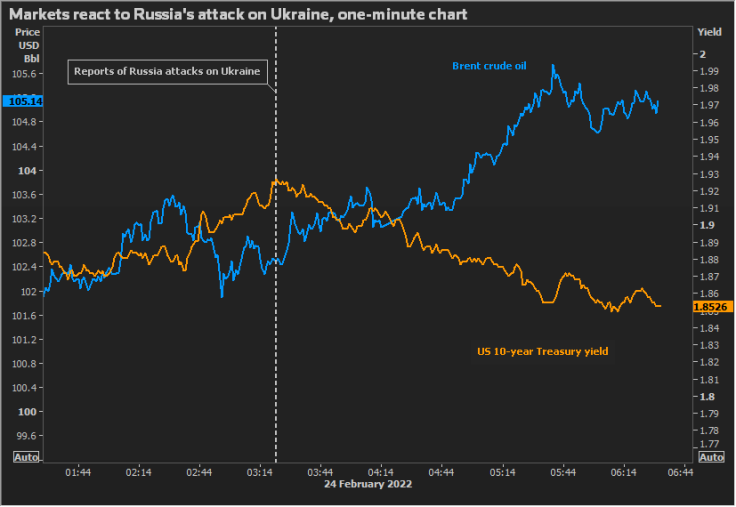Treasury Yields Slide As Russia Invades Ukraine

Investors piled into U.S. government debt on Thursday, pushing Treasury yields sharply lower, after Russia invaded Ukraine, but early declines narrowed as investors assessed the assault's impact on the economy and capital markets.
Ukraine reported columns of troops pouring across its borders from Russia and Belarus and landing on its coast from the Black and Azov seas, in the biggest attack by one country against another in Europe since World War Two.
World stock markets fell and investors fled to safe havens such as U.S. Treasuries and gold. The U.S. dollar strengthened more than 1% against major currencies, and oil rose more than 7% before trimming gains.
The decline in Treasury yields narrowed after U.S. trading opened, as did yields on German 10-year debt as markets closed in Europe.
If the Russian incursion is contained to Ukraine and doesn't cross into any NATO-related country, tensions likely will shift, especially for U.S. assets, said Kevin Flanagan, head of fixed income strategy at WisdomTree Investments.
"In the near term, uncertainty will reign. You will see volatility in the market that will result in a back-and-forth flight-to-quality, safe-haven trade," Flanagan said.
While the invasion of Ukraine is of a far more different scale than Russia's move into Crimea in 2014, it is still more of a Euro-centric issue at the moment, Flanagan said.
"It won't affect U.S.-based behavior for consumers and for businesses unless things spiral into another phase," he said.
The yield on 10-year Treasury notes fell 4.8 basis points to 1.929% after earlier touching 1.846%. The benchmark note had been on track for its biggest daily drop since late November.
A closely watched part of the yield curve measuring the gap between yields on two- and 10-year Treasuries, seen as an indicator of economic expectations, was at 41.7 basis points.
History has shown over the past 50 years that geopolitical events rarely have a long-term sustainable impact on capital markets, said Stan Shipley, strategist at Evercore ISI.
"They do move some sectors, whether you're talking about financial, banking or energy prices," Shipley said. "But the trends we were seeing will probably continue after a short-term pause."
The Federal Reserve, which will hold its next policy meeting on March 15-16, has preferred in the past to delay major policy decisions until uncertainty driven by geopolitical risks has diminished, Goldman Sachs said.
But the current situation is different as inflation risk has created a more urgent reason to tighten, though uncertainty has lowered the odds of a 50-basis-point interest rate hike in March, Goldman said. But Goldman said it sees rates steadily rising by 25 basis points at upcoming meetings.
Money markets priced in an 18.5% probability of a 50-basis-point rate hike in March, or half the odds of such an increase as was registered on Wednesday.
The Ukraine invasion complicates the policy outlook for the Fed as energy and some grains prices will likely rise further if the attack deepens, said John Vail, chief global strategist at Nikko Asset Management.
"The silver lining is that the decline in risk markets has helped prevent bond yields from rising to new yearly highs," he said.
Across the U.S. Treasury curve, yields were sharply lower on the day, with the two-year note down 9.2 basis points at 1.508%.
This echoed moves in European sovereign debt markets, where German Bund yields were set for their biggest daily drop since March 2020 - when the outbreak of COVID-19 threw world markets into turmoil.
Oil prices surged, with international benchmark Brent breaching $100 a barrel for the first time since 2014, as the attack on Ukraine exacerbated concerns about disruptions to global energy supplies.[O/R]
As investors rushed to protect against inflation risks, yields on inflation-linked bonds fell.
The yield on the 10-year Treasury Inflation-Protected Securities (TIPS) was last at 2.6%, indicating that the market sees inflation averaging about 2.6% a year for the next decade.
GRAPHIC: US Treasury yields slide as Russia launches Ukraine invasion -

The breakeven rate on five-year TIPS was last at 3.067%.
The U.S. dollar five-years forward inflation-linked swap, seen by some as a better gauge of inflation expectations due to possible distortions caused by the Fed's quantitative easing, was last at 2.369%.
The Treasury's sale of $50 billion in seven-year notes was strong, with the yield at 1.905%.
© Copyright Thomson Reuters 2024. All rights reserved.




















